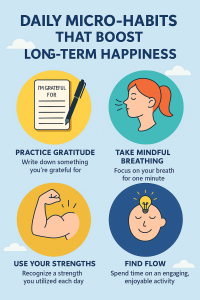Embedding small, intentional micro-habits into your daily life can quietly transform your long-term well-being. Rather than overhauling your routine overnight, these evidence-based practices build positive emotion, resilience, and life satisfaction—one intentional moment at a time. In this comprehensive guide, you’ll learn what micro-habits are, why they matter, and how to implement five powerful daily habits that add up over time.

What Are Micro-Habits and Why They Work
Micro-habits are tiny, easy-to-maintain behaviors—just a minute or two—designed to trigger broader psychological change. Instead of committing to sweeping life changes (like exercising for an hour every day or meditating for thirty minutes), a micro-habit could be as simple as breathing deeply for one minute upon waking, writing one sentence of gratitude, or smiling at a memory. These minimal acts are sustainable, flexible, and low-risk, yet they leverage what psychologists call the compounding effect: small inputs, repeated consistently, create meaningful outputs over time.
Positive psychology research supports that small acts of positive emotion, repeated daily, build psychological resources like resilience, perspective, and social connection. Micro-habits are effective because they bypass resistance: they are too small to ignore, but cumulative enough to create measurable change. In fact, longitudinal studies show that even short gratitude journaling practices can elevate subjective well-being for weeks after completion.
Cultivating Gratitude in Seconds
One of the most robust positive-habit practices is daily gratitude. A micro-version: each morning or evening, take one minute to pause and write down one thing you’re proud of or thankful for. It could be something simple, like a kind word from a colleague, sunshine on your walk, or a small success in your work.
Why this works: Practicing gratitude shifts attention away from what’s lacking and toward what’s already present and good. Neuroscientific studies show that expressing gratitude activates reward-related brain regions and increases neurotransmitters like dopamine and serotonin. Consistent micro-gratitude fosters a mindset of noticing positives—an emotional shift that builds over weeks into a baseline of contentment.
A practical routine: Keep a Post-it pad or a small gratitude journal by your bed or workplace. Each day, write one short line: “I’m grateful for ___.” Review past entries every week. Over time, this habit subtly rewires your internal narrative toward appreciation and abundance.
One-Minute Pause: Mindful Breathing When Transitions Happen
Many habits fail due to complexity—or timing. A readily deployable micro-habit is a brief breathing pause during transitions: before a meeting, after a commute, or before switching tasks. Just a minute of inhaling slowly for four counts and exhaling for six counts helps reset stress and brings conscious focus.
Why it matters: Brief mindfulness helps interrupt mental chatter and diffuses cortisol release. According to research on mindful breathing, even a 60-second pause improves executive function, reduces emotional reactivity, and broadens attention. Making it a cue-based habit—triggered by a routine transition—anchors it naturally.
To integrate it: Use transition zones like closing a laptop or standing from a chair. Every day, practice slowing your breath for one minute before initiating the next activity. Over time, this micro-habit becomes an emotional thermostat and focus enhancer.
Strengths Check-In: One Strength, One Minute
Positive psychology emphasizes using character strengths—qualities like kindness, curiosity, perseverance, or humor—to boost well-being. A practical micro-habit is to take one minute each evening to name one strength you used during the day and reflect on how it added value.
This simple practice encourages self-awareness and affirmation. Over time, recognizing your strengths builds competence, autonomy, and confidence—key components of psychological well-being. Studies referencing the VIA strengths reveal that strength-use interventions reliably improve satisfaction, resilience, and goal progress.
How to do it: Keep a running note on your phone under a heading like “Today I used __.” Choose a different strength each day if possible. Reflect briefly on how it helped you or others. This micro-habit reminds you of your capacity and reinforces intentional behavior.
Meaning Snapshots: Capture Moments That Matter
Finding meaning in daily experiences helps build long-term life satisfaction. A meaning snapshot micro-habit: Once a day, take 60 seconds to note one moment that felt meaningful—like helping someone, being creative, or learning something new. In just a sentence, capture why it mattered.
Over time, these snapshots create a personalized map of what fosters meaning in your life. Studies link meaning-making to greater life satisfaction and lower rates of burnout and depression. Even small, reflective practices support personal growth and resilience.
To practice: Use a notes app or an index card. At day’s end or lunchtime, jot one moment that felt valuable. Ask yourself: “Why did that matter? How did I feel?” Review these snapshots weekly to reaffirm direction and purpose.
Flow in the Margins: Schedule Mini Flow Moments
Flow—the state of focused immersion—boosts motivation and mental clarity. While achieving full-flow may require time, micro-flow moments can be slotted easily: a short puzzle, five minutes of drawing, organizing one small section of your space, or focusing on one challenging sentence in writing.
Why micro-flow helps: These mini experiences spark dopamine production and seed the motivation to tackle larger tasks. Cumulative flow experiences also raise perceived autonomy and meaning. Importantly, they break monotony and reconnect us with skills and interests.
Integrate micro-flow by dedicating a daily time window—even if 5–10 minutes—to an enjoyable, focused activity you love. You can tie it to an anchor: after lunch, after inbox zero, or when completing a meeting. Even brief engagement builds cognitive resilience and pleasure.
How to Combine Micro-Habits Into a Daily Routine
Successful micro-habits become habits because they are tied to cues and repeated with consistency—not because they require significant time. To combine them into a daily routine:
-
Select 2–3 micro-habits you can easily perform in one minute each (e.g., gratitude, breathing pause, strengths check-in).
-
Attach them to regular triggers: waking up, finishing lunch, switching tasks, bedtime.
-
Keep the habit visible: sticky note, app reminder, or short label on your task list.
-
Track progress simply: note yes/no at the end of each day. If you miss one habit occasionally, that’s okay—focus on getting back on it the next day.
-
Review weekly: after seven days, look at your progress and notice any emotional difference.
Over time, these tiny acts build what psychologists call psychological capital: resilience, optimism, hope, self-efficacy, and meaning—minimal investment; sustained payoff.
Final Reflection: Small Steps, Big Impact
Cultivating happiness doesn’t demand grand gestures or a life overhaul. By integrating micro-habits into your day with intention and consistency, you gradually reshape your emotional baseline, build resilience, and open space for growth. Practices like gratitude journaling, brief mindful breathing, strengths recognition, meaning snapshots, and micro-flow moments feed well-being incrementally but meaningfully.
On PositivePsychlopedia.com, you can explore more in-depth resources—guided routines, printable habit trackers, and deeper practice templates—to support your journey of thriving one small step at a time.
